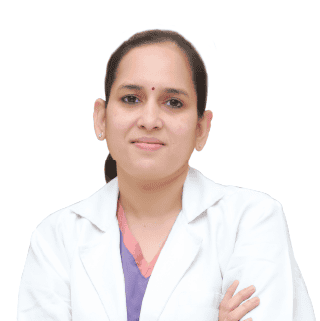
Molar Pregnancy: Causes, Symptoms, and Treatments

Table of Contents
- What Does Pregnancy Molar Mean?
- Types of molar pregnancy
- Symptoms of Molar Pregnancy
- Molar Pregnancy Causes
- Diagnosis for Molar Pregnancy
- Management of Molar Pregnancy
- Molar Pregnancy Treatment Options
- Molar Pregnancy Complications
- Management after Molar Pregnancy Treatment
- Prevention Tips to Avoid Molar Pregnancy
- Conclusion
- Frequently Asked Questions (FAQs)
Even though molar pregnancy is not that common, it is considered a serious medical problem. Pregnancy difficulties arise when aberrant tissue develops in the uterus instead of a healthy embryo. Heavy bleeding, hormonal imbalance, and in rare instances, the development of gestational trophoblastic disease (GTD), a malignant illness, might result from delayed treatment.
In this blog, we will go through the various aspects of molar pregnancies. From their types and symptoms to causes and viable treatments, we will help you understand the nitty-gritty of the same.
Let’s begin.
What Does Pregnancy Molar Mean?
As already mentioned, molar pregnancy is an anomaly which arises when the tissues that would generally form the placenta become a mass of cysts inside the uterus. This happens when the egg is fertilised incorrectly, leading to an overgrowth of placental cells. While not a viable pregnancy, it can be treated successfully with medical care. Early diagnosis and follow-up are essential to prevent complications and ensure recovery.
Types of molar pregnancy
There are two types of molar pregnancy. Let’s know about them in depth:
- Complete Molar Pregnancy: In this type, an egg with no genetic material is fertilised by a sperm. End result? No normal embryo develops. The placental tissue forms abnormal cyst-like structures that grow inside the uterus. The symptoms can include rapid uterine growth, vaginal bleeding, and high levels of pregnancy hormones.
- Partial Molar Pregnancy: In this type, a normal egg is fertilised by two sperms. This leads to the formation of a abnormal embryo with extra chromosomes. The embryo might even start to develop but the chances of its survival are very slim. The placental tissue also grows abnormally. The most common symptoms include mild cramping, bleeding, and signs of early pregnancy.
Both these types of molar pregnancy require medical intervention. This generally means surgical process in which the abnormal tissue is removed. Post that there needs to be constant follow-up to monitor hormone levels and prevent further complications.
Symptoms of Molar Pregnancy
Recognising the symptoms of molar pregnancy is essential for timely medical intervention:
- Vaginal Bleeding: A common sign is unexpected bleeding which can be heavy and painful.
- Severe Morning Sickness and Vomiting (Hyperemesis Gravidarum): This condition is characterised by excessive morning sickness, which is frequently worse than ordinary pregnancy-related nausea.
- Enlarged Uterus: Depending on the gestational age, the uterus may develop more quickly than anticipated.
- Preeclampsia, or High Blood Pressure: Pregnant mothers may be more likely to experience preeclampsia, which is characterised by organ damage and elevated blood pressure.
- Molar Pregnancy Discharge: It is said that if the vaginal discharge is dark in colour it is commonly referred to as molar pregnancy discharge.
Molar Pregnancy Causes
Comprehending the elements that lead to molar pregnancies facilitates risk evaluation. The following are factors that are considered for molar pregnancy causes:
- Genetic Abnormalities: Aberrant tissues can arise as a result of chromosomal mistakes made during fertilisation.
- Maternal Age: There is an increased risk for women over 35.
- Prior Molar Pregnancy: There is a higher chance of recurrence if you have had a prior molar pregnancy.
- Dietary factors: Not getting enough of some nutrients may be a factor.
Diagnosis for Molar Pregnancy
Getting a diagnosis as soon as possible and getting it right is essential to good treatment:
- Ultrasound and Other Diagnostic Tests: One popular diagnostic method is to use ultrasound to visualise the abnormal tissue mass.
- Physical Examination: The doctor will perform a physical examination to check the tenderness or rule out any abnormalities by putting slight pressure around the belly region.
- Removal Procedures: To remove the molar tissue, surgery can be required.
- Observation Care and Monitoring: To identify and address any possible issues, routine monitoring is necessary.
Management of Molar Pregnancy
- Ultrasound and abnormally high hCG levels confirmed the diagnosis.
- Evacuation: Suction dilatation and curettage (D&C) are used to remove molar tissue.
- Histopathology: Examining excised tissue to verify a diagnosis is known as histopathology.
- HCG Monitoring: Weekly hCG tests until normal, followed by monthly testing for six to twelve months.
- Follow Up: During follow-up, contraception is advised to prevent misunderstandings regarding the interpretation of hCG.
- Chemotherapy: If hCG levels rise or stay high, indicating persistent trophoblastic illness, chemotherapy may be administered.
- Follow-up: Extended observation to identify the onset or recurrence of gestational trophoblastic neoplasia (GTN).
Molar Pregnancy Treatment Options
After a series of assessment, the doctor determines which treatment is the best for that particular case. There are multiple options that can be considered as molar pregnancy treatment which is recommended on the basis of the degree of severity.
- Dilation & Curettage (D&C): This widely used procedure includes dilating the cervix and extracting the abnormal tissue from the uterus by scraping or suctioning it out. This treatment option is mostly recommended to patients who have full and partial molar pregnancies.
- Hysterectomy: In this procedure the whole uterus is removed. It is usually recommended for severe cases.
- Observation and Aftercare: It is essential to closely monitor patients after molar tissue removal with blood tests to assess hCG (human chorionic gonadotropin) levels. Following treatment, elevated hCG levels may signify the formation of a persistent gestational trophoblastic neoplasm (GTN) or, in rare instances, permanent molar tissue.
- Chemotherapy: This is the most popular treatment option, but it is only suggested if hCG levels do not return to normal following the initial treatment or if GTN is chronic. Chemotherapy medications are useful in the treatment of gestational trophoblastic disorders because they aid in the removal of aberrant cells.
Note: When a molar pregnancy occurs, the abnormal placental tissue releases an excessive amount of hCG, which results in abnormally high levels. They often grow faster than they would in a typical pregnancy, and they do so even in the absence of foetal development. To make sure all of the molar tissue has been eliminated, keep an eye on the decreasing molar pregnancy hCG levels following therapy.
- Counselling and Emotional Support: Coping with a molar pregnancy can be emotionally taxing. Counselling programmes, support groups, and mental health specialists can all be very helpful in assisting people in managing the emotional effects.
- Pregnancy Avoidance for a Period: After treatment, medical experts frequently recommend avoiding pregnancy for a predetermined amount of time. This gives the body time to heal, and careful observation is usually maintained during this period.
- Genetic counselling: It may be advised in the event of a molar pregnancy, particularly if it is recurring. This entails determining the likelihood of subsequent pregnancies and offering guidance and assistance for responsible family planning.
Molar Pregnancy Complications
Molar pregnancy when not diagnosed or treated on time, it can lead to complications. Here we have mentioned the most common ones:
- Excessive Bleeding: Heavy vaginal bleeding is a common and potentially serious complication. It requires immediate medical attention and in some cases a blood transfusion can be recommended.
- Ovarian Cysts: This is another common complication which shouldn’t be taken lightly. Enlarged ovaries and cyst formation can occur due to elevated hCG levels. This can cause discomfort and hormonal imbalance.
- Persistent Gestational Trophoblastic Disease (GTD): There are some rare cases of molar pregnancy when the tissue continues to grow even after the surgery. This leads to high hCG levels and requires chemotherapy.
- Choriocarcinoma: This is a rare but aggressive cancer that can spread to other organs such as the lungs or the brain.
- Infection & Uterine Damage: Some complications may involve an infection, uterine perforation, or scarring that occur as a side effect to molar tissue removal.
- Emotional Impact: The diagnosis and treatment process can be emotionally draining, which often requires psychological support and counselling.
Management after Molar Pregnancy Treatment
The following tips can help you manage the aftermath of molar pregnancy treatment:
- Managing the psychological side of things is just as crucial as the medical intervention.
- Emotional help: In the difficult emotional aftermath, ask friends and family for help.
- Getting Involved in Support Groups: Making connections with people who have gone through molar pregnancies can foster a feeling of community.
- Seeking Professional Counselling: Getting help from a counsellor can help you deal with anxiety and loss.
Prevention Tips to Avoid Molar Pregnancy
These are a few tips or proactive actions that result in lowering the risk of molar pregnancy:
- Early Prenatal Care: Having frequent examinations helps identify any anomalies early on.
- Genetic counselling: Particularly helpful for partners who have a family history of genetic disorders.
- Sustaining a Healthy Lifestyle: Good lifestyle decisions and a balanced diet support reproductive health in general.
Conclusion
A molar pregnancy can turn into a severe medical condition, but with timely management and the right molar pregnancy treatment, you can try to prepare for a healthy conception the next time. The above-written article gives you a comprehensive idea about what is molar pregnancy, its causes, symptoms and different types of molar pregnancy treatments. Give it a read to understand about this medical condition. If you are diagnosed with molar pregnancy or your previous pregnancy was molar, and you trying for a healthy pregnancy, consult a fertility expert today. You can either call us directly by dialling the above-given number, or you can book an appointment by filling in the details in the appointment form, our coordinator will call you back shortly to understand your query and will connect you with the best fertility expert at Birla Fertility & IVF.
Frequently Asked Questions (FAQs)
What are the possible consequences of molar pregnancy?
In a molar pregnancy, the tissue that normally grows into the placenta instead creates a mass of cysts. This is a rare condition. Complications including preeclampsia, persistent gestational trophoblastic neoplasia (GTN), and possible mental discomfort are among the risks.
Can You Get Pregnant After a Molar Pregnancy?
Although any woman can experience a molar pregnancy, women over 35 are more likely to experience one. Furthermore, some dietary habits or people with a history of molar pregnancies may make them more susceptible.
Does the chance of a molar pregnancy rise due to any particular risk factors?
Yes, there are a few risk factors: dietary issues, a history of molar pregnancies, maternal age over 35, and genetic abnormalities. Early prenatal care and genetic counselling can help reduce these risks.
Is molar pregnancy treatment painful?
The main course of therapy for molar pregnancy is dilatation and curettage (D&C) or, in more extreme situations, a hysterectomy. Even though pain is usually controlled with anaesthesia, the goal is to ensure that the aberrant tissue is removed as effectively as possible. A vital component of the total care is emotional support.
How do I know if I have a molar pregnancy?
If you have extreme nausea, bleeding with grape-like tissue, or abnormally high hCG levels, you may suspect a molar pregnancy. The diagnosis is confirmed by blood testing and an ultrasound
Our Fertility Specialists
Related Blogs
To know more
Birla Fertility & IVF aims at transforming the future of fertility globally, through outstanding clinical outcomes, research, innovation and compassionate care.
Had an IVF Failure?
Talk to our fertility experts

 Our Centers
Our Centers
















